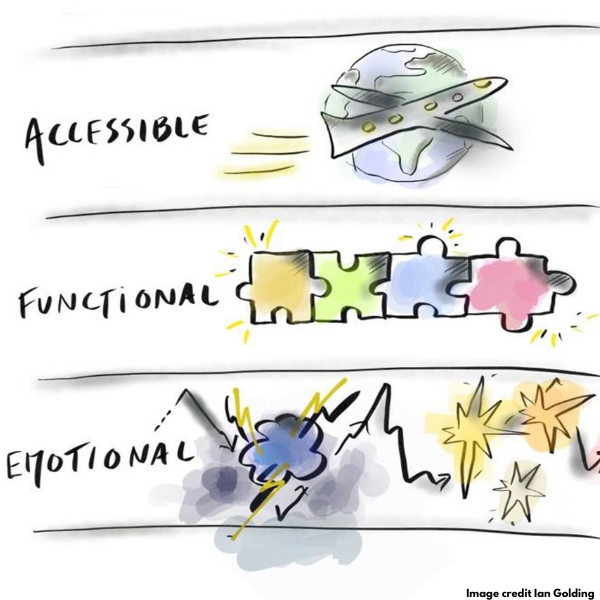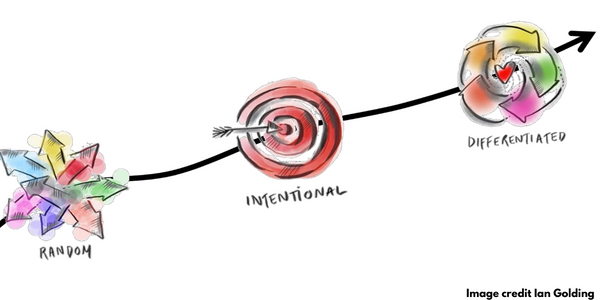The importance of developing a customer-first mindset

- 16 September 2022
CIM course director and customer experience consultant, Ian Golding’s recent webinar, “The science of customer-centricity”, proved extremely popular with attendees. This write-up aims to recap the key points made during the webinar and provide tips and advice to help your business develop a customer first mindset.
What is customer experience?
“Right now, there are many organisations recruiting for what they would describe as customer experience professionals. But actually, what they're looking for are customer service professionals. Customer service and customer experience are not the same thing. Customer service is just one element of the experience that an organisation delivers to its customers, in exactly the same way that sales is, that marketing is, that operations is, that logistics is, - that everything is. Customer experience is the representation of everything an organisation does, that enables its customers to interact with its products and services.”
How has customer experience developed?
“Customer experience can often feel like a lottery […] because most organisations were not created to be customer led, [or] to be customer-centric. They were created to be […] product-centric, sales-centric. As a result of that, those organisations were structured to be focused on products being sold.” Golding continued: “What that means, if I'm being crude, is that organisations are structured to have their people doing lots of stuff, lots of people with their heads down, focused on processes, tasks, and products.”
What Golding means by this is that product-centric and sales-centric organisations focus on being able quantify their output whether through sales, efficiency or other metrics of productivity. This has the effect of diverting the focus of the business away from the customer.
“Most organisations have dozens, hundreds, sometimes 1000s of internally focused metrics, measuring [their] people doing stuff. And [they’re] equally as obsessed with measuring the stuff that [they] shouldn't be doing.” This leads to an odd impasse where, as Golding elaborated, “organisations have lots of metrics, telling them what's going wrong. But what they're failing to do is to stop [those] things from going wrong.”
For these product-centric and sales-centric organisations, an inability to react to or prevent things from going wrong will eventually prove problematic for their customers and ultimately, themselves. Golding quipped, this is “another irony of customer experience only becoming recognised as a discipline in relatively recent times.”
What are the three essential elements of customer experience?
All experiences contain these three core elements: the functional, the accessible, and the emotional.
Accessible
“Over the last ten to 15 years, differentiation has moved from being solely about the functional to being as much about the accessible element. How easy is it for your customer to interact with your products and services? The principle being, the more accessible the experience becomes, the more likely it is a customer will come to you rather than going to one of your competitors.”
Functional
“The functional elements of all experiences represent your products and your services. Most organisations on the planet were created to differentiate themselves on that functional element alone. And marketing functions all around the world have worked incredibly hard to increase the ability of the organisation to get those products and services in front of customers to find, win and keep customers for as long as possible.”
Emotional
“Whilst you can't have an experience without the functional and the accessible, it is actually the third element, that's the most important of the three. Because the third element is the emotional one. The emotional element representing the way the experience makes your customer feel. And the reason this is the most important element of the three is because the way the experience makes your customer feel is what they are most likely to remember.
“With all experiences, customers will remember one of three things: they'll remember very good things, they'll remember very bad things, or they will remember nothing at all. And it's actually that third outcome, that is the worst of the three.”
What is the customer experience continuum?
Random
“On the left hand side of the line, [businesses are] delivering what we call random or unexpected experiences. In other words, as a customer, you never quite know what's going to happen. If you think of organisations that you interact with, as a consumer in your own right, on a daily, weekly or monthly basis: the thought of contacting your energy provider, your telco your bank, in many instances, that [interaction] will not fill your heart with joy.
“Because very often, we know before we even try and contact an organisation, it could be difficult. It might not, but it might well be. We might get through, we might not get through. They might answer [our] question, they might not answer [our] question. Golding illustrated this point further by stating “A phrase that I continually use is that ‘bad experiences cost money’. And if we can eliminate these things that are continuously going wrong in the customer experience, we can actually save millions.”
Intentional
“To get to the middle of the continuum, [it is important to] re-evaluate how we measure what we do. We cannot just [utilise] internally focused metrics, metrics that the business cares about, we must balance that with a truthful, measurable understanding of what's important to the customer, and the employee.
“[Getting] to the middle of this continuum and beyond can only happen with good cross functional governance. It is impossible to persistently, consistently, sustainably, deliver the experience you want your customers to have, until or unless every leader, every team, every department, every function is prepared to link arms and work together to deliver the experience together. Regrettably, that is not happening.
“As you all know, we live in a world of organisational silos. And those silos unfortunately, in many organisations, seem to have become even more siloed. As a result of the pandemic, we're not working together, we're often working against each other. Until that changes, this aspiration of customer-centricity will remain just an aspiration, it is unlikely to become a reality.”
Differentiated
“On the right hand side of this continuum, as I said, are the most customer-centric organisations on Earth. This is where organisations like Amazon fit in. I must make it clear that the overwhelming majority on the right hand side of this continuum were created that way. Very few legacy businesses or organisations have transformed themselves successfully to get to the right hand side, even fewer have been able to stay on the right hand side.
“If you are a sustainably customer-centric organisation, which means you're able to differentiate not just on your products and services, but the whole experience, you have got to be incredibly easy to interact with. Golding continued, “If you have even the slightest sense, you are not as easy to interact with as you could be, you have not yet made it to the right-hand side.”
How can we develop a sustainably customer-first mindset?
“The newer the business, in principle, the easier it should be. The most important thing comes back to that cross-functional collaboration. But I think there needs to be an acknowledgement of the collective leadership team, that the strategic intent of the organisation is to achieve its business goals through a customer-led strategy. So I think it’s absolutely critical to get that collective agreement from the very beginning.”
Golding continued, “if that will is there, then what is essential is to create a strategy that is balanced. And what I mean by that is, it's very likely that a new business will have a business strategy [and] it is essential to balance that with a customer experience strategy, those two things sit alongside each other. Golding explained that positioning the business strategy and the customer experience strategy alongside each other will help facilitate “a clear understanding of what the business wants, and what the customer wants.
“By adopting this balanced strategy that is supported by balanced measurement, going forward, you should then achieve a customer-led objective. Because you're not just trying to hit the sales number, you're doing it at the same time as trying to deliver the strategic intent behind your customer experience strategy.”
Do you have any top tips for helping businesses to gain a customer-focused perspective?
“The only other thing I would say, and this might sound remarkably simple, but […] I'd like to state the blindingly obvious” joked Golding, “a consideration that you might want to share with your colleagues is the next time you sit down as a business, as a leadership team, start the meeting by talking about recent customer experiences.
“Don't start by talking about the numbers. Start by talking about the customer experience, things that customers have said, things that customers like or don't like, if you start every meeting, talking about customer experience, you will be thinking like a customer, even when you start to get to business-related matters.”
If you want to learn more about customer experience and how your organisation can go about delivering a sustainable, customer-centric experience, you can check out our “Managing the Customer Experience” course. CIM members can also watch Ian Golding’s full webinar on-demand now via the CIM Content hub.

Tags:
- 0 views

 FAQs
FAQs
 Log in
Log in
 MyCIM
MyCIM









